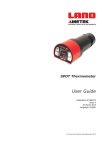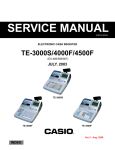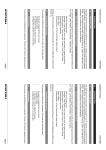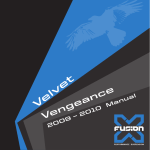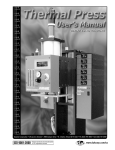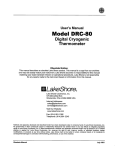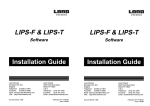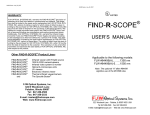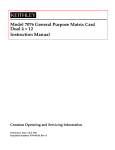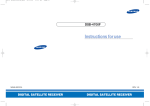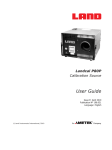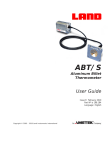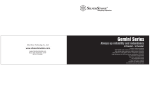Download User Guide Thermometer User Guide Thermometer - E
Transcript
Land Infrared 10 Friends Lane Newtown, PA 18940-1804 U.S.A. Telephone: (215) 504 8000 Facsimile: (215) 504 0879 Email: [email protected] Thermometer Land Infrared Dronfield S18 1DJ England Telephone: (01246) 417691 Facsimile: (01246) 410585 Email: [email protected] Part Nº 198.006 [Publication Nº S4970333] Issue B 03/02 Thermometer Land Infrared 10 Friends Lane Newtown, PA 18940-1804 U.S.A. Telephone: (215) 504 8000 Facsimile: (215) 504 0879 Email: [email protected] © Land Infrared, 2002 User Guide Land Infrared Dronfield S18 1DJ England Telephone: (01246) 417691 Facsimile: (01246) 410585 Email: [email protected] Part Nº 198.006 [Publication Nº S4970333] Issue B 03/02 User Guide © Land Infrared, 2002 User Guide Thermometer User Guide Thermometer The Quality Management System of Land Instruments International Ltd. is approved to BS EN ISO9001:2000 for the design and manufacture, stockholding, in-house repair and site servicing of non contact temperature measuring instrumentation. Associated software designed and developed in accordance with TickIT. ABC abcdefg The Quality Management System of Land Instruments International Ltd. is approved to BS EN ISO9001:2000 for the design and manufacture, stockholding, in-house repair and site servicing of non contact temperature measuring instrumentation. Associated software designed and developed in accordance with TickIT. Calibration certificates are available from our UKAS accredited Calibration Laboratory No. 0034. The Land calibration laboratory complies with the requirements of the international standard BS EN/IEC 17025. ABC abcdefg Calibration certificates are available from our UKAS accredited Calibration Laboratory No. 0034. The Land calibration laboratory complies with the requirements of the international standard BS EN/IEC 17025. of Quality Assurance trademark This product complies with current European directives relating to electromagnetic compatibility and safety (EMC directive 89/336/EEC; Low voltage directive 73/23/EEC). Landmark ® is a registered Land Instruments International Ltd. This product complies with current European directives relating to electromagnetic compatibility and safety (EMC directive 89/336/EEC; Low voltage directive 73/23/EEC). of All packaging material used for this product is 100% trademark All packaging material used for this product is 100% Landmark ® is a registered Land Instruments International Ltd. Quality Assurance Thermometer SAFETY INFORMATION Symbol Safety Information User Guide Thermometer SAFETY INFORMATION User Guide Direct current Description IEC 417, No. 5031 Alternating current Publication Direct current IEC 417, No. 5032 Both direct and alternating current Symbol IEC 417, No. 5031 Alternating current IEC 417, No. 5033 Description IEC 417, No. 5032 Both direct and alternating current Publication IEC 417, No. 5033 IEC 417, No. 5020 IEC 417, No. 5019 IEC 417, No. 5017 Equipotentiality Frame or chassis terminal Protective terminal Earth (ground) terminal IEC 417, No. 5007 IEC 417, No. 5021 IEC 417, No. 5020 IEC 417, No. 5019 IEC 417, No. 5017 Off (Supply) On (Supply) Equipotentiality Frame or chassis terminal Protective terminal Earth (ground) terminal IEC 617-2, No. 02-02-06 Three-phase alternating current IEC 417, No. 5021 On (Supply) IEC 417, No. 5008 IEC 617-2, No. 02-02-06 Three-phase alternating current IEC 417, No. 5007 Off (Supply) conductor IEC 417, No. 5008 IEC 417, No. 5172 Equipment protected throughout by double insulation or reinforced insulation (equivalent to Class II of IEC 536) conductor IEC 417, No. 5172 Equipment protected throughout by double insulation or reinforced insulation (equivalent to Class II of IEC 536) Safety Information User Guide User Guide Publication Caution, risk of electric shock Description Thermometer Description ISO 3864, No. B.3.6 Caution Thermometer Publication Caution, risk of electric shock ISO 3864, No. B.3.1 SAFETY INFORMATION (Continued) ISO 3864, No. B.3.6 Caution Observe precautions for handling electrostatic discharge sensitive devices Symbol ISO 3864, No. B.3.1 BS EN 100015 Warning, laser radiation SAFETY INFORMATION (Continued) Symbol BS EN 100015 Observe precautions for handling electrostatic discharge sensitive devices BS EN 60825: 1992 Warning, laser radiation Warning, hot surface BS EN 60825: 1992 Warning, hot surface Refer to the Operating Instructions. Safety Information Refer to the Operating Instructions. Safety Information Thermometer Blank User Guide Thermometer Blank User Guide User Guide 1.0 2.0 3.0 4.0 5.0 6.0 Contents Thermometer 1 1 1 1 1 3 INTRODUCTION 1.1 1.2 1.3 1.4 1.5 4 About this guide About the thermometer About System 4 Unpacking the thermometer Nomenclature SPECIFICATIONS 4 5 6 7 8 9 10 11 Series Thermometers Series Thermometers Series Thermometers Series Thermometers Series Thermometers Series Thermometers Series Thermometers Series Thermometers 2.1 2.2 2.3 2.4 2.5 2.6 2.7 2.8 12 M1 M2 M4 M5 M6 M7 M8 R1 INSTALLING THE THERMOMETER 12 14 16 Choosing a location for the thermometer 19 3.1 19 19 20 21 22 14 EMISSIVITY TABLES 4.1 4.2 Refractories Alloys Metals Plastics Miscellaneous USING THE THERMOMETER 5.1 5.2 5.3 5.4 5.5 23 Focusing the lens on the target Electrical Connections MAINTENANCE Contents User Guide 1.0 2.0 3.0 4.0 5.0 6.0 Contents Thermometer 1 1 1 1 1 3 INTRODUCTION 1.1 1.2 1.3 1.4 1.5 4 About this guide About the thermometer About System 4 Unpacking the thermometer Nomenclature SPECIFICATIONS 4 5 6 7 8 9 10 11 Series Thermometers Series Thermometers Series Thermometers Series Thermometers Series Thermometers Series Thermometers Series Thermometers Series Thermometers 2.1 2.2 2.3 2.4 2.5 2.6 2.7 2.8 12 M1 M2 M4 M5 M6 M7 M8 R1 INSTALLING THE THERMOMETER 12 14 16 Choosing a location for the thermometer 19 3.1 19 19 20 21 22 14 EMISSIVITY TABLES 4.1 4.2 Refractories Alloys Metals Plastics Miscellaneous USING THE THERMOMETER 5.1 5.2 5.3 5.4 5.5 23 Focusing the lens on the target Electrical Connections MAINTENANCE Contents Thermometer Blank User Guide Thermometer Blank User Guide User Guide Thermometer Jacket Fig. 1 Land System 4 thermometer Air Purge Thermometer S4970222 Back Cap S4970223 Fig. 2 System 4 Thermometer with Air Purge, Protection Jacket and Back Cap Preface User Guide Thermometer Jacket Fig. 1 Land System 4 thermometer Air Purge Thermometer S4970222 Back Cap S4970223 Fig. 2 System 4 Thermometer with Air Purge, Protection Jacket and Back Cap Preface Thermometer Blank User Guide Thermometer Blank User Guide 1.0 About this guide INTRODUCTION Thermometer INTRODUCTION 1.1 User Guide 1.0 About this guide Thermometer 1.1 This guide gives the information necessary for you to operate a LAND System 4 Thermometer. Basic information regarding installation is contained within the Installation Guide. More detailed information regarding servicing, repair and calibration of the thermometer is contained in the Service Manual. User Guide This guide gives the information necessary for you to operate a LAND System 4 Thermometer. Basic information regarding installation is contained within the Installation Guide. More detailed information regarding servicing, repair and calibration of the thermometer is contained in the Service Manual. About the thermometer 1.2 About the thermometer 1.2 Focusable optical system with through-the-lens sighting to give precise target definition. 4 to 20mA output, linear over the temperature span of the thermometer. The LAND System 4 thermometer is a highly accurate, focusable, non contact thermometer designed for use in conjunction with the System 4 Landmark processors. About System 4 The LAND System 4 thermometer is a highly accurate, focusable, non contact thermometer designed for use in conjunction with the System 4 Landmark processors. Focusable optical system with through-the-lens sighting to give precise target definition. 4 to 20mA output, linear over the temperature span of the thermometer. 1.3 The thermometer features include: About System 4 The thermometer features include: 1.3 LAND System 4 is a range of high accuracy thermometers, state of the art processors and rugged mounting accessories designed to provide precise, non contact temperature measurement in a wide range of industrial applications. LAND System 4 is a range of high accuracy thermometers, state of the art processors and rugged mounting accessories designed to provide precise, non contact temperature measurement in a wide range of industrial applications. An air purge, protection jacket and back cap are available for use with the thermometer in hostile locations. An air purge, protection jacket and back cap are available for use with the thermometer in hostile locations. Unpacking the thermometer 1.4 Unpacking the thermometer 1.4 The package containing the thermometer will contain the following items: Envelope containing this User Guide. Binder, for your thermometer and processor user documentation. System 4 thermometer (fitted with protection caps on the lens and the eyepiece). Eye comfort filter. Fitted only to instruments where the temperature range exceeds 1600°C/2900°F. The thermometer will be supplied pre-fitted with either a Standard lens (denoted VG/VC) or a Short Focus lens (denoted SG/SF). The package containing the thermometer will contain the following items: It is recommended that the front lens protection cap is kept attached until the thermometer is installed and that the eyepiece cap continues to be used after installation. Envelope containing this User Guide. Binder, for your thermometer and processor user documentation. System 4 thermometer (fitted with protection caps on the lens and the eyepiece). Eye comfort filter. Fitted only to instruments where the temperature range exceeds 1600°C/2900°F. The thermometer will be supplied pre-fitted with either a Standard lens (denoted VG/VC) or a Short Focus lens (denoted SG/SF). It is recommended that the front lens protection cap is kept attached until the thermometer is installed and that the eyepiece cap continues to be used after installation. Page 1 Page 1 Thermometer Thermometer Series User Guide Thermometer Series Silicon cell (1µm) Germanium cell (1.6µm) Lead Sulphide cell (2.4µm) Thermopile (4.8 to 5.2µm) Lead Selenide cell (3 to 5µm) Lead Selenide cell (3.43µm) Thermopile (8 to 14µm) M Single wavelength R Ratio 1 2 4 5 6 7 8 Minimum temperature Maximum temperature User Guide Optics V Optics C Fig. 3 System 4 Thermometer nomenclature S4T006001 V Variable Focus (Standard) S Short Variable Focus L Fibroptic V S4T006001 V Variable Focus (Standard) S Short Variable Focus L Fibroptic 1 6 0 0 Units 6 0 0 Units 1 C Degrees Celsius F Degrees Fahrenheit C C Degrees Celsius F Degrees Fahrenheit Maximum temperature 1 6 0 0 Fig. 3 System 4 Thermometer nomenclature 6 0 0 Minimum temperature Silicon cell (1µm) Germanium cell (1.6µm) Lead Sulphide cell (2.4µm) Thermopile (4.8 to 5.2µm) Lead Selenide cell (3 to 5µm) Lead Selenide cell (3.43µm) Thermopile (8 to 14µm) M Single wavelength R Ratio 1 2 4 5 6 7 8 1 M Wavelength M Page 2 Wavelength Thermometer Page 2 User Guide Thermometer 1.5 Thermometer 1.5 The thermometer detail label is on the rear face of the thermometer above the eyepiece. The thermometer instrument type nomenclature is explained in Fig. 3. User Guide The thermometer detail label is on the rear face of the thermometer above the eyepiece. The thermometer instrument type nomenclature is explained in Fig. 3. Make a note of your thermometers instrument type and Serial Number in the space provided below. This information is required to configure a Landmark processor to work with your thermometer. Nomenclature Make a note of your thermometers instrument type and Serial Number in the space provided below. This information is required to configure a Landmark processor to work with your thermometer. Instrument type: Nomenclature Instrument type: Serial Number: Page 3 Serial Number: Page 3 Thermometer User Guide Thermometer M1 450/1000C M1 850/1850F M1 600/1600C M1 1100/2900F M1 800/2600C M1 1500/4700F User Guide Thermometer Model 1500 to 4700°F SPECIFICATIONS M1 1500/4700F 800 to 2600°C 2.0 M1 800/2600C 1100 to 2900°F SPECIFICATIONS M1 1100/2900F Temperature Range: 600 to 1600°C 6° through the lens 5ms (0 to 95%) 1µm 850 to 1850°F Sighting: Response Time: Wavelength: 450 to 1000°C 2.0 M1 600/1600C 1500 to 4700°F M1 Series Thermometers M1 850/1850F 800 to 2600°C 2.1 M1 450/1000C 1100 to 2900°F M1 Series Thermometers Thermometer Model 600 to 1600°C 2.1 Temperature Range: 850 to 1850°F 6° through the lens 5ms (0 to 95%) 1µm 450 to 1000°C Wavelength: Response Time: Sighting: 1.8x >98% of energy within graticule 200:1 <1K 0.3°/°ambient 0.7%K <2K 1.8mm (0.07in) 0.4%K Vibration: To IP65 / NEMA 4X requirements 0 to 99% non condensing 3G any axis 10 to 300 Hz 2°C (4°F) per year 0.2°/°ambient 3.5mm (0.13in) 0.35m (13.6in) to 1.0m (39.3in) 0.5m (19.7in) to infinity 100:1 30mm (1.2in) Target Size: 30:1 Magnification: Repeatability: Accuracy Min. Target Diameter: Short Variable Focus: Standard: Focus Range Field Of View (Nominal): Eye Relief: 1.8x 200:1 >98% of energy within graticule 100:1 30mm (1.2in) <2K Absolute: Stability (Temperature): Humidity: 11.7mm (0.70in) Target Size: 30:1 0.5m (19.7in) to infinity <1K 0.7%K 1.8mm (0.07in) 0.4%K 0.3°/°ambient 3.5mm (0.13in) 0.35m (13.6in) to 1.0m (39.3in) 0.2°/°ambient 3G any axis 10 to 300 Hz Sealing: 11.7mm (0.70in) Magnification: Eye Relief: Field Of View (Nominal): Focus Range Standard: Min. Target Diameter: Short Variable Focus: Accuracy Repeatability: Absolute: Stability (Temperature): 0 to 99% non condensing Stability (Time): Vibration: To IP65 / NEMA 4X requirements 2°C (4°F) per year Humidity: Stability (Time): Sealing: -10 to 80°C (14 to 176°F) 0 to 70°C (32 to 158°F) Ambient Temperature Specified: Ambient Temperature 0 to 70°C (32 to 158°F) EN 50-082-2 (immunity) EN 50-081-1 (emission) IEC 1010 (safety) Specified: Page 4 CE Operating: EN 50-082-2 (immunity) EN 50-081-1 (emission) IEC 1010 (safety) -10 to 80°C (14 to 176°F) CE Operating: Page 4 User Guide User Guide Thermometer 600 to 2000°F M2 600/2000F Thermometer 300 to 1100°C M2 300/1100C M2 Series Thermometers Thermometer Model 2.2 Temperature range: M2 Series Thermometers 600 to 2000°F M2 600/2000F 2.2 300 to 1100°C 1.6µm 100:1 30mm (1.2in) 1.8x >98% of energy within graticule image 6°, through the lens 5ms (0 to 95%) M2 300/1100C Field of view (nominal): Eye relief: Magnification: Target size: Sighting: Response time: Wavelength: Thermometer Model 1.6µm 100:1 30mm (1.2in) 1.8x >98% of energy within graticule image 6°, through the lens 5ms (0 to 95%) Temperature range: Wavelength: Response time: Sighting: Target size: Magnification: Eye relief: Field of view (nominal): 0.5m (19.7in) to infinity 0.35m (13.6in) to 1.0m (39.3in) Standard: Focus range: Short variable focus: 0.5m (19.7in) to infinity 0.35m (13.6in) to 1.0m (39.3in) 3.5mm (0.13in) Standard: Focus range: Short variable focus: Min. target diameter: Accuracy Repeatability: <1K 3.5mm (0.13in) <1K Min. target diameter: Accuracy Repeatability: 0.25%K + 1K 0.2°/°ambient Absolute: Stability (Temp): 0.25%K + 1K 0.2°/°ambient Absolute: 0 to 99% non condensing 3G Any axis 10 to 300 Hz Stability (Temp): Vibration: 2°C (4°F) per year Humidity: Stability (Time): 0 to 99% non condensing 3G Any axis 10 to 300 Hz 2°C (4°F) per year Vibration: Stability (Time): Humidity: Specified: 0 to 50°C (32 to 122°F) IP65 Sealing: 0 to 50°C (32 to 122°F) Page 5 EN 50-082-2 (immunity), EN 50-081-1 (emission), IEC 1010 (safety) -10 to 60°C (14 to 140°F) CE: Operating: Ambient temperature: IP65 Sealing: Specified: Ambient temperature: -10 to 60°C (14 to 140°F) EN 50-082-2 (immunity), EN 50-081-1 (emission), IEC 1010 (safety) Operating: CE: Page 5 Thermometer Thermometer 50 to 250°C M4 50/250C 150 to 500°F M4 150/500F 150 to 550°C M4 150/550C 300 to 1000°F M4 300/1000F User Guide Thermometer Model User Guide Temperature range: M4 Series Thermometers 300 to 1000°F M4 300/1000F 2.3 150 to 550°C M4 150/550C M4 Series Thermometers 150 to 500°F M4 150/500F 2.3 50 to 250°C Response time: Sighting: Target size: Magnification: Eye relief: Field of view (nominal): Standard: Focus range: Short variable focus: 1.8x 30mm/1.2in 0.5m/19.7in to infinity 100:1 0.35m/13.6in to 1.0m/39.3in 3.5mm/0.13in <1K 11.7mm/0.46in 30:1 >98% of energy within graticule image 6°, through the lens 100ms/0 to 95% 2.4µm M4 50/250C 100:1 Wavelength: Thermometer Model 1.8x 30mm/1.2in 0.5m/19.7in to infinity 0.35m/13.6in to 1.0m/39.3in Min. target diameter: <1K Accuracy Repeatability: 3.5mm/0.13in <1K 4K 11.7mm/0.46in 30:1 >98% of energy within graticule image 6°, through the lens 100ms/0 to 95% 2.4µm Temperature range: Wavelength: Response time: Sighting: Target size: Magnification: Eye relief: Field of view (nominal): Standard: Focus range: Short variable focus: Min. target diameter: <1K 3K Accuracy Repeatability: Absolute: 0.1°/°ambient 4K Stability (Temp): 3K 0.1°/°ambient Absolute: Stability (Temp): Vibration: 0 to 99% non condensing 3G Any axis 10 to 300 Hz 1°C/2°F per year Humidity: Stability (Time): 0 to 99% non condensing 3G Any axis 10 to 300 Hz 1°C/2°F per year Vibration: Stability (Time): Humidity: Specified: 5 to 45°C/41 to 113°F IP65 Sealing: 5 to 45°C/41 to 113°F EN 50-082-2 (immunity), EN 50-081-1 (emission), IEC 1010 (safety) 0 to 50°C/32 to 122°F Page 6 CE: Operating: Ambient temperature: IP65 Sealing: Specified: Ambient temperature: 0 to 50°C/32 to 122°F EN 50-082-2 (immunity), EN 50-081-1 (emission), IEC 1010 (safety) Operating: CE: Page 6 User Guide Thermometer User Guide 400 to 1300°C M5 400/1300C 750 to 2400°F M5 750/2400F 1000 to 2500°C 1800 to 4500°F M5 1000/2500C Thermometer Thermometer Model M5 Series Thermometers Temperature range: 2.4 M5 1000/2500C M5 Series Thermometers 1000 to 2500°C 1800 to 4500°F 2.4 M5 750/2400F Response time: Sighting: Target size: Magnification: Eye relief: Field of view (nominal): Standard: Focus range: Short variable focus: Min. target diameter: Accuracy Repeatability 100ms (0 to 95%) 6°, through the lens 1K 0.5%K 1K 0.02%T(K)/°Cambient 0.6%K 3.5mm (0.13in) 0.35m (13.6in) to 1.0m (39.3in) 0.5m (19.7in) to infinity 100:1 30mm (1.2in) 1.8x >98% of energy within graticule image M5 1800/4500F 750 to 2400°F M5 1800/4500F 400 to 1300°C 1K Absolute: Stability (Temp): 4.8 to 5.2µm M5 400/1300C 1K 0.5%K Wavelength: Thermometer Model 0.6%K 0.02%T(K)/°Cambient 3.5mm (0.13in) 0.35m (13.6in) to 1.0m (39.3in) 0.5m (19.7in) to infinity 100:1 30mm (1.2in) 1.8x >98% of energy within graticule image 6°, through the lens 100ms (0 to 95%) 4.8 to 5.2µm Temperature range: Wavelength: Response time: Sighting: Target size: Magnification: Eye relief: Field of view (nominal): Standard: Focus range: Short variable focus: Min. target diameter: Accuracy Repeatability Absolute: Stability (Temp): Vibration: 0 to 99% non condensing 3G Any axis 10 to 300 Hz 2°C (4°F) per year Humidity: Stability (Time): 0 to 99% non condensing 3G Any axis 10 to 300 Hz 2°C (4°F) per year Vibration: Stability (Time): Humidity: Specified: 0 to 70°C (32 to 158°F) IP65 Sealing: 0 to 70°C (32 to 158°F) Page 7 EN 50-082-2 (immunity), EN 50-081-1 (emission), IEC 1010 (safety) -10 to 80°C (14 to 176°F) CE: Operating: Ambient temperature: IP65 Sealing: Specified: Ambient temperature: -10 to 80°C (14 to 176°F) EN 50-082-2 (immunity), EN 50-081-1 (emission), IEC 1010 (safety) Operating: CE: Page 7 Thermometer Thermometer 50 to 600°F M6 50/600F 100 to 700°C M6 100/700C 200 to 1300°F M6 200/1300F User Guide 0 to 300°C M6 0/300C User Guide Thermometer Model M6 Series Thermometers Temperature range: 2.5 M6 200/1300F M6 Series Thermometers 200 to 1300°F 2.5 M6 100/700C 3 to 5µm (nominal) 100 to 700°C <100ms (0 to 95%) M6 50/600F Wavelength: 50 to 600°F Response time: 0 to 300°C 3 to 5µm (nominal) M6 0/300C <100ms (0 to 95%) Thermometer Model Wavelength: Temperature range: Response time: 6°, through the lens Magnification: Eye relief: Field of view (nominal): Standard: Focus range: Short variable focus: Min. target diameter: Accuracy Repeatability: Absolute: Stability (Temp): 1.8x 30mm/1.2in 0.5m/19.7in to infinity 100:1 0.35m/13.6in to 1.0m/39.3in 0.3%K + 1.5K <1K 0.2°/°ambient 0.3%K + 2K <1K 3.5mm/0.13in 0.15°/°ambient 11.7mm/0.46in 30:1 >98% of energy within graticule image Sighting: 100:1 Target size: 6°, through the lens 1.8x 30mm/1.2in 0.5m/19.7in to infinity 0.35m/13.6in to 1.0m/39.3in <1K 3.5mm/0.13in <1K 0.3%K + 2K 0 to 99% non condensing 3G Any axis 10 to 300 Hz 0.2°/°ambient Vibration: 0.3%K + 1.5K 2°C/4°F per year Humidity: Stability (Time): 0 to 99% non condensing 3G Any axis 10 to 300 Hz 0.15°/°ambient 11.7mm/0.46in 30:1 >98% of energy within graticule image Sighting: Target size: Magnification: Eye relief: Field of view (nominal): Standard: Focus range: Short variable focus: Min. target diameter: Accuracy Repeatability: Absolute: Stability (Temp): 2°C/4°F per year Vibration: Stability (Time): Humidity: Specified: 5 to 45°C/41 to 113°F IP65 Sealing: 5 to 45°C/41 to 113°F EN 50-082-2 (immunity), EN 50-081-1 (emission), IEC 1010 (safety) 0 to 50°C/32 to 122°F Page 8 CE: Operating: Ambient temperature: IP65 Sealing: Specified: Ambient temperature: 0 to 50°C/32 to 122°F EN 50-082-2 (immunity), EN 50-081-1 (emission), IEC 1010 (safety) Operating: CE: Page 8 User Guide Thermometer M7 Series Thermometers User Guide 2.6 Thermometer 75 to 700°F M7 75/700F M7 Series Thermometers 25 to 375°C M7 25/375C 2.6 Thermometer Model 3.43µm (nominal) Temperature range: <100ms (0 to 95%) 75 to 700°F Wavelength: M7 75/700F Response time: 25 to 375°C 3.43µm (nominal) M7 25/375C <100ms (0 to 95%) Thermometer Model Wavelength: Temperature range: Response time: 6°, through the lens 1.5°C/2.7°F 11.7mm/0.46in 0.35m/13.6in to 1.0m/39.3in 0.5m/19.7in to infinity 30:1 30mm/1.2in 1.8x >98% of energy within graticule image Sighting: Repeatability Accuracy Min. target diameter: Short variable focus: Standard: Focus range: Field of view (nominal): Eye relief: Magnification: Target size: 6°, through the lens 1.5°C/2.7°F 11.7mm/0.46in 0.35m/13.6in to 1.0m/39.3in 0.5m/19.7in to infinity 30:1 30mm/1.2in 1.8x >98% of energy within graticule image Sighting: Target size: Magnification: Eye relief: Field of view (nominal): Standard: Focus range: Short variable focus: Min. target diameter: Accuracy Repeatability 3K 0.1°/° amb Absolute: Stability (Temp): 3K 0.1°/° amb Absolute: 0 to 99% non condensing 3G Any axis 10 to 300 Hz Stability (Temp): Vibration: 2°C/4°F per year Humidity: Stability (Time): 0 to 99% non condensing 3G Any axis 10 to 300 Hz 2°C/4°F per year Vibration: Stability (Time): Humidity: Specified: 5 to 45°C/41 to 113°F IP65 Sealing: 5 to 45°C/41 to 113°F Page 9 EN 50-082-2 (immunity), EN 50-081-1 (emission), IEC 1010 (safety) 0 to 50°C/32 to 122°F CE: Operating: Ambient temperature: IP65 Sealing: Specified: Ambient temperature: 0 to 50°C/32 to 122°F EN 50-082-2 (immunity), EN 50-081-1 (emission), IEC 1010 (safety) Operating: CE: Page 9 Thermometer Temperature Range: Therm ometer Model 0 to 1000°C M8 0/1000C 30 to 1830°F M8 30/1830F User Guide 30 to 1830°F M8 30/1830F M8 Series Thermometers 0 to 1000°C M8 0/1000C 2.7 Therm ometer Model 8 to 14µm 100ms (0 to 95%) Wavelength: 6° through the lens 8 to 14µm Response Time: Wavelength: 100ms (0 to 95%) >98% of energy within graticule Response Time: Target Size: Sighting: >98% of energy within graticule 6° through the lens Target Size: 1.8x 0.3°/°ambient 2K 1%K+1K <1K 5mm (0.2in) 0.5m (19.7in) to infinity 100:1 30mm (1.2in) Magnification: Stability (Temperature): Interchangeability: Absolute: Repeatability: Accuracy Min. Target Diameter: Standard: Focus Range Field Of View (Nominal): Eye Relief: 1.8x 30mm (1.2in) 100:1 0.5m (19.7in) to infinity 5mm (0.2in) <1K 1%K+1K 2K 0.3°/°ambient 3G any axis 10 to 300 Hz Sealing: Humidity: Vibration: To IP65 / NEM A 4X requirements 0 to 99% non condensing 3G any axis 10 to 300 Hz 2°C (4°F) per year 0 to 99% non condensing Stability (Time): Vibration: To IP65 / NEM A 4X requirements 2°C (4°F) per year Humidity: 0 to 70°C (32 to 158°F) 0 to 45°C (32 to 113°F) CE Operating: Specified: EN 50-082-2 (immunity) 0 to 70°C (32 to 158°F) 0 to 45°C (32 to 113°F) Ambient Temperature Specified: EN 50-082-2 (immunity) IEC 1010 (safety) EN 50-081-1 (emission) Operating: IEC 1010 (safety) EN 50-081-1 (emission) CE Ambient Temperature Sealing: Stability (Time): Stability (Temperature): Interchangeability: Absolute: Repeatability: Accuracy Min. Target Diameter: Standard: Focus Range Field Of View (Nominal): Eye Relief: Magnification: Sighting: Page 10 Temperature Range: M8 Series Thermometers Thermometer 2.7 Page 10 User Guide User Guide Thermometer User Guide Thermometer R1 1100/2900F R1 Series Thermometers 1100 to 2900°F 1000 to 2600°C 1800 to 4700°F 2.8 R1 600/1600C R1 Series Thermometers 600 to 1600°C 2.8 Thermometer Model 15ms (0 to 95%) 6°, through the lens 1.8x 30mm/1.2in 0.5m/19.7in to infinity 200:1 0.35m/13.6in to 1.0m/39.3in <1.1%K <2K 1.8mm/0.07in <1K 0.1%/°ambient 7mm/0.27in 50:1 >98% of energy within graticule image R1 1800/4700F Temperature range: R1 1000/2600C R1 1100/2900F R1 1800/4700F 1100 to 2900°F 1000 to 2600°C 1800 to 4700°F R1 1000/2600C R1 600/1600C Response time: Sighting: Target size: Magnification: Eye relief: Field of view (nominal): Standard: Focus range: Short variable focus: 0.85 to 1.1µm 600 to 1600°C 200:1 Wavelength: Thermometer Model 1.8x 30mm/1.2in 0.5m/19.7in to infinity 0.35m/13.6in to 1.0m/39.3in Min. target diameter: <0.65%K Accuracy 0.05%/°ambient 1.8mm/0.07in <2K Stability (Temp): 7mm/0.27in 50:1 >98% of energy within graticule image 6°, through the lens 15ms (0 to 95%) 0.85 to 1.1µm Temperature range: Wavelength: Response time: Sighting: Target size: Magnification: Eye relief: Field of view (nominal): Standard: Focus range: Short variable focus: Min. target diameter: <1.1%K 2°C/4°F per year Accuracy <1K 0.1%/°ambient 2°C/4°F per year Repeatability: <0.65%K Stability (Time): Repeatability: 0.05%/°ambient 2°C/4°F per year 0 to 99% non condensing 3G Any axis 10 to 300 Hz Humidity: Vibration: 0 to 99% non condensing 3G Any axis 10 to 300 Hz Absolute: Stability (Temp): 2°C/4°F per year Vibration: Absolute: Stability (Time): Humidity: Specified: 0 to 50°C/32 to 122°F IP65 Sealing: 0 to 50°C/32 to 122°F Page 11 EN 50-082-2 (immunity), EN 50-081-1 (emission), IEC 1010 (safety) -10 to 60°C/14 to 140°F CE: Operating: Ambient temperature: IP65 Sealing: Specified: Ambient temperature: -10 to 60°C/14 to 140°F EN 50-082-2 (immunity), EN 50-081-1 (emission), IEC 1010 (safety) Operating: CE: Page 11 Thermometer User Guide 3.0 User Guide 3.0 This section contains similar information to the thermometer Installation Guide. Thermometer This section contains similar information to the thermometer Installation Guide. If the thermometer is to be used in conjunction with a protection jacket and air purge, refer to the installation guides provided with those accessories. INSTALLING THE THERMOMETER If the thermometer is to be used in conjunction with a protection jacket and air purge, refer to the installation guides provided with those accessories. If the thermometer is to be installed in a location where the ambient temperature is within the ranges specified for the thermometer, and no air purging is required to keep the lens clean, the thermometer can be mounted using the two tapped holes on the mounting pad. Either hole can be used for direct tripod mounting. INSTALLING THE THERMOMETER If the thermometer is to be installed in a location where the ambient temperature is within the ranges specified for the thermometer, and no air purging is required to keep the lens clean, the thermometer can be mounted using the two tapped holes on the mounting pad. Either hole can be used for direct tripod mounting. 3.1 A swivel ball mounting (S4 - B) is available from Land infrared. This mounting accessory enables you to easily adjust the thermometer's line of sight. 3.1 If your thermometer is an 'M' series thermometer (e.g. M1 600 / 1600 C), it must be positioned such that, at the chosen target distance, the target is large enough to completely fill the area covered by the graticule of the eyepiece (Refer to Section 3.1.1). The thermometer's view of the target area must not be obstructed. A swivel ball mounting (S4 - B) is available from Land infrared. This mounting accessory enables you to easily adjust the thermometer's line of sight. If your thermometer is an 'M' series thermometer (e.g. M1 600 / 1600 C), it must be positioned such that, at the chosen target distance, the target is large enough to completely fill the area covered by the graticule of the eyepiece (Refer to Section 3.1.1). The thermometer's view of the target area must not be obstructed. If your thermometer is an 'R' series thermometer (e.g. R1 1000 / 2600 C), it is not essential for the target to completely fill the area covered by the graticule. Choosing a location for the thermometer If your thermometer is an 'R' series thermometer (e.g. R1 1000 / 2600 C), it is not essential for the target to completely fill the area covered by the graticule. The overall dimensions of the thermometer installation are given in Fig. 4. Choosing a location for the thermometer The overall dimensions of the thermometer installation are given in Fig. 4. Target size calculation 3.1.1 Target size calculation 3.1.1 The standard lens The short focus lens There are two types of lens available for use with the System 4 thermometer. The standard lens The short focus lens For both lenses, the target area is defined as the area covered by the graticule. There are two types of lens available for use with the System 4 thermometer. For both lenses, the target area is defined as the area covered by the graticule. To calculate the minimum target size at any distance, refer to Fig. 5. Focusable from 500mm to infinity denoted [VG/VC] Focusable from 350mm to 1000mm denoted [SG/SF] To calculate the minimum target size at any distance, refer to Fig. 5. Page 12 Focusable from 500mm to infinity denoted [VG/VC] Focusable from 350mm to 1000mm denoted [SG/SF] Page 12 User Guide 80.5mm /3.17in Thermometer Allow 480mm/19.0in. for sighting access User Guide 80.5mm /3.17in Ensure that the thermometer has an unobstructed view of the target Target Size ( d ) Target Distance ( s ) Thermometer Target Distance ( s ) FOV* Fig. 5 Target Size calculation Page 13 S4970226 * FOV -Refer to your thermometer’s specification for this value. i.e. If the Field of view is 100:1, use '100' for the FOV value. Target Size ( d ) = S4970225 Allow 480mm/19.0in. for sighting access Mounting Pad: 2 holes, ¼in BSW, 7mm/0.3in deep on 25mm/0.98in centres S4970226 Page 13 Fig. 4 Thermometer installation dimensions Mounting Pad: 2 holes, ¼in BSW, 7mm/0.3in deep on 25mm/0.98in centres Ensure that the thermometer has an unobstructed view of the target Target Size ( d ) Target Distance ( s ) Target Distance ( s ) FOV* Fig. 5 Target Size calculation * FOV -Refer to your thermometer’s specification for this value. i.e. If the Field of view is 100:1, use '100' for the FOV value. Target Size ( d ) = S4970225 114mm/4.49in Fig. 4 Thermometer installation dimensions 114mm/4.49in Thermometer User Guide Thermometer USING THE THERMOMETER User Guide 4.0 USING THE THERMOMETER 4.0 NOTE Once the thermometer has been installed in its chosen location, the lens must be focused on the target area. NOTE If the object to be measured is suspected of being at a temperature higher than 1600°C ensure that the eye comfort filter is fitted before proceeding with installation. Once the thermometer has been installed in its chosen location, the lens must be focused on the target area. If the object to be measured is suspected of being at a temperature higher than 1600°C ensure that the eye comfort filter is fitted before proceeding with installation. Remove the lens protection cap from the thermometer. Focusing the lens on the target (i) Remove the eyepiece protection cap on the rear face of the thermometer to reveal the Focus ring (See Fig. 6). 4.1 Remove the lens protection cap from the thermometer. (ii) Focusing the lens on the target Remove the eyepiece protection cap on the rear face of the thermometer to reveal the Focus ring (See Fig. 6). (iii) Look through the eyepiece. If you wear spectacles, you do not need to remove them, as the graticule image is positioned for viewing either with or without corrected vision. 4.1 (i) Look through the eyepiece. If you wear spectacles, you do not need to remove them, as the graticule image is positioned for viewing either with or without corrected vision. The target area is defined as the area within the graticule. To focus on the target. (ii) The target area is defined as the area within the graticule. NOTE To focus on the target. (iii) NOTE If the required target is not within the graticule, adjust the thermometer mounting until the target fills the graticule. The image in the viewfinder appears upside down. (iv) NOTE To move the focus nearer to the thermometer turn the ring clockwise. Turn the focus ring to bring the target into focus. NOTE (v) A range of thermometer mounting accessories, to suit all measurement locations, is available from Land Infrared. Turn the focus ring to bring the target into focus. To move the focus nearer to the thermometer turn the ring clockwise. Page 14 A range of thermometer mounting accessories, to suit all measurement locations, is available from Land Infrared. If the required target is not within the graticule, adjust the thermometer mounting until the target fills the graticule. The image in the viewfinder appears upside down. (iv) (v) Page 14 User Guide G ra tic u l e Ensure that, for 'M' series thermometers, the target completely fills the area covered by the graticule. Focus Ring Adjust focus ring to bring target into focus. Turn clockwise to focus on near objects. Turn anticlockwise to focus on distant objects. Keyway Marker Thermometer MADEI N ENGLAND TYPE:M1 1100/2900F V SERI AL No. 0000000/ 00/00 S4970229 S4970228 Electrical connection socket on rear of thermometer S4970227 Fig. 6 Location of Focus Ring and Graticule on rear face of thermometer 1100 /2900 F V M AD E I N EN GL A N D TY P E : M1 S E R I A L N o . 0 0 00 0 0 0 / 0 0/ 0 0 Lugs Fig. 7 Location of 6-way electrical connection socket Locking Sleeve Marker Fig. 8 Connection of the pre-wired cable to the thermometer Page 15 User Guide G ra tic u l e Ensure that, for 'M' series thermometers, the target completely fills the area covered by the graticule. Focus Ring Adjust focus ring to bring target into focus. Turn clockwise to focus on near objects. Turn anticlockwise to focus on distant objects. Keyway Marker Thermometer MADEI N ENGLAND TYPE:M1 1100/2900F V SERI AL No. 0000000/ 00/00 S4970229 S4970228 Electrical connection socket on rear of thermometer S4970227 Fig. 6 Location of Focus Ring and Graticule on rear face of thermometer 1100 /2900 F V M AD E I N EN GL A N D TY P E : M1 S E R I A L N o . 0 0 00 0 0 0 / 0 0/ 0 0 Lugs Fig. 7 Location of 6-way electrical connection socket Locking Sleeve Marker Fig. 8 Connection of the pre-wired cable to the thermometer Page 15 Thermometer User Guide Thermometer User Guide (viii) (vii) (vi) Electrical Connections When the target is in focus and, for 'M' series thermometers, the target fills the graticule, replace the eyepiece protection cap and ensure that the thermometer is mounted securely. Make any necessary adjustments to the thermometer's mounting to ensure that it is viewing the required target. To check that the target is in focus, use the 'parallax' method. i.e. look through the eyepiece and make small side-to-side movements of your head. The target is in best focus when there is no apparent movement of the image with respect to the graticule. 4.2 (viii) (vii) (vi) Electrical Connections When the target is in focus and, for 'M' series thermometers, the target fills the graticule, replace the eyepiece protection cap and ensure that the thermometer is mounted securely. Make any necessary adjustments to the thermometer's mounting to ensure that it is viewing the required target. To check that the target is in focus, use the 'parallax' method. i.e. look through the eyepiece and make small side-to-side movements of your head. The target is in best focus when there is no apparent movement of the image with respect to the graticule. To move the focus away from the thermometer turn the ring anticlockwise. 4.2 The electrical connections for the thermometer's power supply, emissivity input and temperature output are made via the 6-way socket on the rear of the thermometer. See Fig. 7. To move the focus away from the thermometer turn the ring anticlockwise. The electrical connections for the thermometer's power supply, emissivity input and temperature output are made via the 6-way socket on the rear of the thermometer. See Fig. 7. Electrical connection to the thermometer must be made by either the pre-wired plug (LAND Part Nº 029.673) or via the plug housed in the Back Cap (LAND Part Nº 091.562). Refer to Fig. 8. Align the red marker near the lugs of the pre-wired plug with the red marker above the keyway in the socket on the thermometer. Electrical connection to the thermometer must be made by either the pre-wired plug (LAND Part Nº 029.673) or via the plug housed in the Back Cap (LAND Part Nº 091.562). (i) Push the plug into the socket. To connect the cable; Refer to Fig. 8. Align the red marker near the lugs of the pre-wired plug with the red marker above the keyway in the socket on the thermometer. (ii) To connect the cable; (i) Push the plug into the socket. Grip the locking sleeve section of the plug. (ii) (i) Pull the plug outwards to release the locking mechanism and disconnect the cable. To disconnect the cable; Grip the locking sleeve section of the plug. (ii) To disconnect the cable; (i) Pull the plug outwards to release the locking mechanism and disconnect the cable. Page 16 (ii) Page 16 Label 4 to 20mA linear tem perature signal drive 4 to 20mA linear tem perature signal return 4 to 20mA emissivity signal drive Screen 24 to 30V d.c. power (positive) 24 to 30V d.c. power (negative) 4 to 20mA emissivity signal return Function Thermometer Cable Colour T TE+ Screen V VE- User Guide Function Yellow Blue White Screen Red Black Green Thermometer Label 4 to 20mA linear tem perature signal drive 4 to 20mA linear tem perature signal return 4 to 20mA emissivity signal drive Screen 24 to 30V d.c. power (positive) 24 to 30V d.c. power (negative) 4 to 20mA emissivity signal return User Guide Cable Colour T TE+ Screen V VE- Green Type B White line 4 White 5 6 Black 3 Red 1 Blue 2 Yellow View from solder bucket side of 6-w ay connectors S4970482 Type A Green White Black Yellow Green Type B White line 4 White Fig. 9 Cable connection schedule Screen is connected to shell of connector at thermometer end of cable and pin 4 of processor connector. Red Blue 6 Black 3 Red 1 Blue 2 Yellow Page 17 S4970482 View from solder bucket side of 6-w ay connectors 5 Note:Two different variants of plug may be encountered - Type A or Type B Yellow Blue White Screen Red Black Green Black Yellow Blue Note:Two different variants of plug may be encountered - Type A or Type B Type A Green White Red Screen is connected to shell of connector at thermometer end of cable and pin 4 of processor connector. Fig. 9 Cable connection schedule Page 17 Thermometer User Guide Thermometer User Guide 4.2.1 Electrical connection to Landmark processors 4.2.1 The electrical connections required by the System 4 Thermometer are as follows: Electrical connection to Landmark processors The electrical connections required by the System 4 Thermometer are as follows: NOTE 30V between V+ and V-. 4 to 20mA input on E+ and E- to represent emissivity of 0.2 to 1.0. 4 to 20mA output on T+ and T- giving temperature linearly across the thermometer range. NOTE R series thermometers read under-range for 2 to 3 minutes after turn-on, as the thermometer warms up. (i) (ii) (iii) R series thermometers read under-range for 2 to 3 minutes after turn-on, as the thermometer warms up. When the thermometer is used in conjunction with a System 4 Landmark Processor, the thermometer derives its power supply, emissivity input and temperature output from the processor. To connect the thermometer to the processor, use the 6-way cable from the thermometer to wire up the 7-way cable connector supplied with the processor (Refer to the Processor Installation Guide). The cable connection schedule is given in Fig. 9. 30V between V+ and V-. 4 to 20mA input on E+ and E- to represent emissivity of 0.2 to 1.0. 4 to 20mA output on T+ and T- giving temperature linearly across the thermometer range. When the thermometer is used in conjunction with a System 4 Landmark Processor, the thermometer derives its power supply, emissivity input and temperature output from the processor. To connect the thermometer to the processor, use the 6-way cable from the thermometer to wire up the 7-way cable connector supplied with the processor (Refer to the Processor Installation Guide). The cable connection schedule is given in Fig. 9. Page 18 (i) (ii) (iii) Page 18 User Guide Thermometer User Guide EMISSIVITY TABLES Refractories Thermometer 5.0 EMISSIVITY TABLES 5.1 M aterial - 0.80 M8 0.60 0.90 - 0.80 0.60 0.90 - Refractories System 4 Thermometer Series M2 M4 M6 0.30 0.30 0.40 0.80 0.80 0.93 0.35 - red 0.30 0.60 Alumina w hite refractory 0.60 0.60 0.50 - M8 0.03 0.60 0.30 0.80 0.05 0.35 0.10 0.85 0.10 0.70 0.20 0.85 S4T006002 0.55 0.60 0.40 - Alloys A lloy s System 4 Thermometer Series M2 M4 M6 0.18 0.10 0.70 0.70 0.61 0.30 0.30 0.80 0.80 0.20 0.22 0.60 0.60 0.30 0.30 0.28 0.85 0.85 0.85 0.22 0.20 0.10 0.70 0.70 0.45 0.28 0.85 0.85 0.90 silica sillimanite Ceramics M agnesite M1 0.30 0.80 5.0 Refractories M aterial 0.80 M8 0.60 0.90 - Refractories System 4 Thermometer Series M2 M4 M6 0.30 0.30 0.40 0.80 0.80 0.93 - 0.80 0.60 0.90 - M1 0.30 0.80 0.35 - red 0.30 0.60 Alumina w hite refractory 0.60 0.60 0.50 - 5.2 M aterial M1 0.20 0.70 0.30 0.80 0.25 0.65 0.30 0.85 0.25 0.70 0.30 0.85 S4T006003 Brass Oxidised Chromel & Alumel Oxidised Constantin & M anganin Oxidised Inconel Oxidised M onel Oxidised Nichrome Oxidised S4T006003 Page 19 M8 0.03 0.60 0.30 0.80 0.05 0.35 0.10 0.85 0.10 0.70 0.20 0.85 S4T006002 0.55 0.60 0.40 - A lloy s System 4 Thermometer Series M2 M4 M6 0.18 0.10 0.70 0.70 0.61 0.30 0.30 0.80 0.80 0.20 0.22 0.60 0.60 0.30 0.30 0.28 0.85 0.85 0.85 0.22 0.20 0.10 0.70 0.70 0.45 0.28 0.85 0.85 0.90 silica sillimanite Ceramics M agnesite Alloys M1 0.20 0.70 0.30 0.80 0.25 0.65 0.30 0.85 0.25 0.70 0.30 0.85 Brick In order to obtain accurate temperature measurements, the emissivity value of the target surface must be known. This section of the Thermometer User Guide contains emissivity values of the most commonly measured materials for each System 4 thermometer. Where no emissivity value is quoted, this means that either the thermometer is not suitable for the measurement application or the temperature of the target is outside the thermometer's measurement span. If you have a query regarding the emissivity of the target in your measurement application, contact Land Infrared. Brick In order to obtain accurate temperature measurements, the emissivity value of the target surface must be known. This section of the Thermometer User Guide contains emissivity values of the most commonly measured materials for each System 4 thermometer. Where no emissivity value is quoted, this means that either the thermometer is not suitable for the measurement application or the temperature of the target is outside the thermometer's measurement span. If you have a query regarding the emissivity of the target in your measurement application, contact Land Infrared. 5.1 5.2 M aterial Brass Oxidised Chromel & Alumel Oxidised Constantin & M anganin Oxidised Inconel Oxidised M onel Oxidised Nichrome Oxidised Page 19 Aluminium Oxidised Chromium Oxidised Cobalt Oxidised Copper Oxidised Gold Iron & Steel Oxidised Lead Oxidised M agnesium Oxidised M olybdenum Oxidised Nickel Oxidised Palladium Platinum Rhodium Silver Oxidised Tin Oxidised Titanium Oxidised Tungsten Z inc Oxidised Material Metals Thermometer 5.3 Page 20 M1 0.13 0.40 0.43 0.75 0.32 0.70 0.06 0.85 0.05 0.35 0.85 0.35 0.65 0.27 0.75 0.33 0.80 0.35 0.85 0.28 0.27 0.25 0.05 0.10 0.40 0.60 0.55 0.80 0.39 0.50 0.60 Metals System 4 Thermometer Series M2 M4 M6 0.09 0.08 0.05 0.40 0.40 0.30 0.34 0.15 0.80 0.28 0.18 0.65 0.05 0.04 0.04 0.85 0.85 0.85 0.02 0.02 0.02 0.18 0.30 0.85 0.85 0.85 0.28 0.16 0.65 0.65 0.63 0.24 0.20 0.12 0.75 0.75 0.25 0.07 0.80 0.80 0.80 0.25 0.15 0.85 0.23 0.08 0.22 0.18 0.10 0.18 0.07 0.04 0.04 0.03 0.10 0.10 0.28 0.12 0.09 0.60 0.60 0.50 0.42 0.30 0.80 0.30 0.20 0.13 0.32 0.10 0.05 0.55 0.11 User Guide M8 0.025 0.35 0.07 0.85 0.04 0.35 0.03 0.80 0.02 0.10 0.80 0.13 0.65 0.07 0.75 0.10 0.80 0.04 0.85 0.05 0.07 0.05 0.02 0.12 0.06 0.60 0.15 0.60 0.06 0.04 0.30 S4T006004 Aluminium Oxidised Chromium Oxidised Cobalt Oxidised Copper Oxidised Gold Iron & Steel Oxidised Lead Oxidised M agnesium Oxidised M olybdenum Oxidised Nickel Oxidised Palladium Platinum Rhodium Silver Oxidised Tin Oxidised Titanium Oxidised Tungsten Z inc Oxidised Material Metals Thermometer 5.3 Page 20 M1 0.13 0.40 0.43 0.75 0.32 0.70 0.06 0.85 0.05 0.35 0.85 0.35 0.65 0.27 0.75 0.33 0.80 0.35 0.85 0.28 0.27 0.25 0.05 0.10 0.40 0.60 0.55 0.80 0.39 0.50 0.60 Metals System 4 Thermometer Series M2 M4 M6 0.09 0.08 0.05 0.40 0.40 0.30 0.34 0.15 0.80 0.28 0.18 0.65 0.05 0.04 0.04 0.85 0.85 0.85 0.02 0.02 0.02 0.18 0.30 0.85 0.85 0.85 0.28 0.16 0.65 0.65 0.63 0.24 0.20 0.12 0.75 0.75 0.25 0.07 0.80 0.80 0.80 0.25 0.15 0.85 0.23 0.08 0.22 0.18 0.10 0.18 0.07 0.04 0.04 0.03 0.10 0.10 0.28 0.12 0.09 0.60 0.60 0.50 0.42 0.30 0.80 0.30 0.20 0.13 0.32 0.10 0.05 0.55 0.11 User Guide M8 0.025 0.35 0.07 0.85 0.04 0.35 0.03 0.80 0.02 0.10 0.80 0.13 0.65 0.07 0.75 0.10 0.80 0.04 0.85 0.05 0.07 0.05 0.02 0.12 0.06 0.60 0.15 0.60 0.06 0.04 0.30 S4T006004 User Guide 5.4 Plastics (M7 Thermometer Only) Plastics Material Acrylic Cellulose Acetate Polyester (PET ) Polyamide (Nylon) Polycarbonate Polyethylene Polypropylene Polystyrene Polyurethane Polyvin yl Chloride (PVC) Polyvinyiliden e Chloride (PVDC) 5 0.18 0.11 0.03 0.35 0.07 0.58 0.61 0.18 0.14 0.16 0.02 10 0.35 0.24 0.09 0.59 0.18 0.82 0.84 0.35 0.29 0.33 0.08 20 0.59 0.44 0.21 0.82 0.34 0.94 0.95 0.59 0.51 0.56 0.18 40 0.82 0.69 0.39 0.94 0.58 0.96 0.96 0.82 0.76 0.80 0.35 T hickness (µm) 80 60 0.94 0.91 0.88 0.82 0.64 0.53 0.96 0.96 0.82 0.73 0.96 0.96 0.96 0.96 0.94 0.91 0.92 0.87 0.93 0.90 0.59 0.49 100 0.95 0.92 0.72 0.96 0.87 0.96 0.96 0.95 0.94 0.94 0.67 150 0.96 0.95 0.83 0.96 0.93 0.96 0.96 0.96 0.96 0.96 0.81 200 0.96 0.96 0.90 0.96 0.95 0.96 0.96 0.96 0.96 0.96 0.88 300 0.96 0.96 0.94 0.96 0.96 0.96 0.96 0.96 0.96 0.96 0.94 S4T006005 Thermometer Page 21 User Guide 5.4 Plastics (M7 Thermometer Only) Plastics Material Acrylic Cellulose Acetate Polyester (PET ) Polyamide (Nylon) Polycarbonate Polyethylene Polypropylene Polystyrene Polyurethane Polyvin yl Chloride (PVC) Polyvinyiliden e Chloride (PVDC) 5 0.18 0.11 0.03 0.35 0.07 0.58 0.61 0.18 0.14 0.16 0.02 10 0.35 0.24 0.09 0.59 0.18 0.82 0.84 0.35 0.29 0.33 0.08 20 0.59 0.44 0.21 0.82 0.34 0.94 0.95 0.59 0.51 0.56 0.18 40 0.82 0.69 0.39 0.94 0.58 0.96 0.96 0.82 0.76 0.80 0.35 T hickness (µm) 80 60 0.94 0.91 0.88 0.82 0.64 0.53 0.96 0.96 0.82 0.73 0.96 0.96 0.96 0.96 0.94 0.91 0.92 0.87 0.93 0.90 0.59 0.49 100 0.95 0.92 0.72 0.96 0.87 0.96 0.96 0.95 0.94 0.94 0.67 150 0.96 0.95 0.83 0.96 0.93 0.96 0.96 0.96 0.96 0.96 0.81 200 0.96 0.96 0.90 0.96 0.95 0.96 0.96 0.96 0.96 0.96 0.88 300 0.96 0.96 0.94 0.96 0.96 0.96 0.96 0.96 0.96 0.96 0.94 S4T006005 Thermometer Page 21 Miscellaneous Thermometer 5.5 Material Asbestos (Board/Paper/Cloth) Asphalt graphite Carbon soot Cement & Concrete Cloth (all types-close w eave) [Open weave reduces emissiv ity] 3mm thick 6mm thick Glass 12mm thick 20mm thick Page 22 0.80 M2 0.90 0.85 0.85 0.95 0.70 0.85 0.96 0.96 0.96 0.96 >0.90 >0.90 >0.90 >0.90 0.85 M6 0.90 0.90 0.85 0.95 0.90 - M8 0.90 0.85 0.80 0.95 0.90 User Guide M1 0.90 0.85 0.85 0.95 0.65 - Miscellaneous Materials System 4 Thermometer Series M4 M5 - 0.75 - - 0.80 S4T006006 Miscellaneous Thermometer 5.5 Material Asbestos (Board/Paper/Cloth) Asphalt graphite Carbon soot Cement & Concrete Cloth (all types-close w eave) [Open weave reduces emissiv ity] 3mm thick 6mm thick Glass 12mm thick 20mm thick Page 22 0.80 M2 0.90 0.85 0.85 0.95 0.70 0.85 0.96 0.96 0.96 0.96 - >0.90 >0.90 >0.90 >0.90 0.85 M6 0.90 0.90 0.85 0.95 0.90 - M8 0.90 0.85 0.80 0.95 0.90 User Guide M1 0.90 0.85 0.85 0.95 0.65 - Miscellaneous Materials System 4 Thermometer Series M4 M5 0.75 - - 0.80 S4T006006 User Guide Thermometer User Guide Thermometer 6.0 MAINTENANCE 6.0 Thermometer maintenance consists mainly of ensuring that the lens is clean. If the lens becomes dirty clean it with lens cleaning fluid and a soft cloth. MAINTENANCE Thermometer maintenance consists mainly of ensuring that the lens is clean. If the lens becomes dirty clean it with lens cleaning fluid and a soft cloth. WARNING If it is found that the lens is repeatedly becoming dirty, it may be necessary to use the thermometer in conjunction with the System 4 air purge (LAND Part Nº 091.561). Contact LAND Infrared for more information. WARNING Never 'over-cool' the thermometer as this may result in condensation either on or inside the thermometer. If it is found that the lens is repeatedly becoming dirty, it may be necessary to use the thermometer in conjunction with the System 4 air purge (LAND Part Nº 091.561). Contact LAND Infrared for more information. Never 'over-cool' the thermometer as this may result in condensation either on or inside the thermometer. The flow rate required for cooling water is 1 litre per minute (0.035 cu. ft per minute). If the thermometer is used in conjunction with a cooling jacket, ensure that there is an adequate supply of cooling water. The flow rate required for cooling water is 1 litre per minute (0.035 cu. ft per minute). If the thermometer is used in conjunction with an air purge, check that there is an adequate supply of clean air. If the thermometer is used in conjunction with a cooling jacket, ensure that there is an adequate supply of cooling water. If the thermometer is used in conjunction with an air purge, check that there is an adequate supply of clean air. The flow rate required for purge air is 1 litre per second (2 cu. ft per minute). Page 23 The flow rate required for purge air is 1 litre per second (2 cu. ft per minute). Page 23 Thermometer Blank User Guide Thermometer Blank User Guide


































